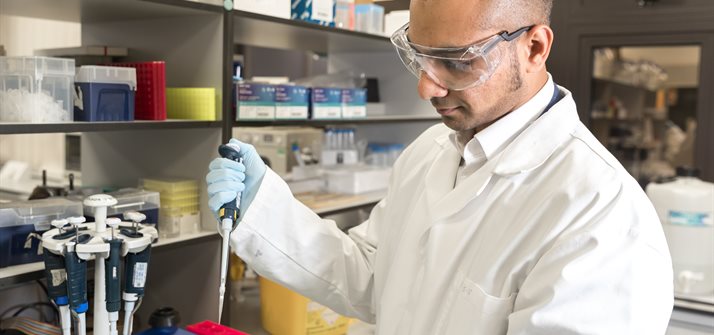
The CBTRC undertakes a wide range of research in the field of molecular characterisation of brain tumours. This allows us to establish prognostic markers, and molecular targets for diagnosis and treatments. These will help stratify medicine and lead to the delivery of more refined treatments.
Major Projects
SIOP Ependymoma Trial & BIOMECA
The International Society of Paediatric Oncology (SIOP) Ependymoma II trial is an, international clinical trial for the diagnosis and treatment of children, adolescents and young adults with ependymoma. The trial is being coordinated in the UK by The University of Birmingham’s Cancer Research UK Clinical Trials Unit.
BIOMECA (BIOMarkers of Ependymoma in Children and Adolescents) is a new biological study attached to SIOP Ependymoma II. This is organised by the European Ependymoma Biology Consortium, which comprises research groups in the UK, Germany, France and Italy. The CBTRC is responsible for the UK arm of BIOMECA and leads the BIOMECA consortium. Through BIOMECA, researchers are aiming to learn more about the biology of the disease. This work is led by Professor Richard Grundy, supported by Dr Rebecca Chapman, Dr Lisa Storer, and Clinical colleagues.
BIOMECA focusses on developing a better understanding of the underlying biology of ependymoma as a key step to improving treatment. The research will enable doctors to tailor subsequent therapy, and potentially detect molecular defects in the tumour that can be targeted directly with specific drugs. The overriding aim is to improve the survival of children with ependymoma and decrease the side effects that are associated with current treatments.
Our secondary objective as part of the discovery work package, is to begin investigating whether we can detect minimal residual disease in ependymoma patients via miRNA biomarkers in cerebrospinal fluid (CSF) or blood. This work will coincide with patients on the SIOP Ependymoma II Trial who have recurrent/relapse disease.
This is a major international initiative and the CBTRC team host weekly teleconferences with Cancer Centres across Europe to review patients’ radiology images and to collectively make decisions about the surgical and treatment options available to those recruited to the trial.
Cancer Research UK’s ‘Kids and Teens’ partnership with TK Maxx is funding the UK arm of the SIOP II trial and part of BIOMECA. Additional funding for BIOMECA has been generoulsy supported by Children with Cancer UK. The trial will treat around 500 children and young adults with ependymoma, up to the age of 22 years.
Medulloblastoma is the most common form of brain tumour in children. One-third of patients are metastatic at diagnosis, meaning that the cancer has already spread to other parts of the body, for example, to the spinal cord.
One of the central hypotheses we are exploring is the theory that there are some treatment resistant cells in a tumour, which remain after treatment and reseed tumour growth. CBTRC academics are researching a means to overcome this drug resistance and restore the effectiveness of chemotherapy, for both medulloblastoma and ependymoma patients. This focus has the potential to be adopted in CSF targeted treatment strategies, and drug delivery research page.
We are also developing 3D tumour models, which are more representative of tumours and their microenvironments in the human body, than are 2D cell line models. This will help researchers to better understand the tumour biology and to develop targeted approaches to inhibit the mechanisms behind chemo-resistance and migration.
Paediatric High-Grade Glioma (pHGG) and Diffuse Intrinsic Pontine Glioblastoma (DIPG)
Brain tumours are rare but devastating diseases, affecting over 500 children every year in the UK. Paediatric High-Grade Glioma (pHGG) and Diffuse Intrinsic Pontine Glioblastoma (DIPG) are two tumour types which are especially difficult to treat.
CBTRC has a small programme of research focusses on these tumour types focussing on developing a better understanding of the biology of pHGG and DIPG to develop novel therapies. This has been examining how the tumours form, how antibodies could target the cells, and how the parts of the cell responsible for tumour formation could potentially be blocked. Overall, this research will lead to a better understanding of pHGG/DIPG brain tumour biology, as well as paving the way for the development of new-targeted therapies to treat these catastrophic illnesses in children.
Glioblastoma multiforme (GBM) is the most aggressive form of High Grade Glioma, and the most common malignant brain tumour in adults. CBTRC’s work in this area includes both adult and paediatric GBM. Through working in this way, we have been able to demonstrate the familiarities and differences between adult and paediatric GBM, and the consequences of this for biology, treatment and recovery.
CBTRC’s research into GBM involves collaborations with a range of researchers from different disciplines, both from Nottingham and beyond. Our investigations in this area cover aspects of high resolution imaging studies, immunotherapy, radio-sensitisation and novel stem cell markers. The academics working on GBM work closely with clinicians, and have formed the Nottingham Glioma Group. This group’s research is wide ranging, and includes studying the metabolites and gene expression profiles of glioma cells, and how these vary across different regions of the brain tumour, in vivo models for neurosurgically applied local drug delivery, intra-tumour heterogeneity.